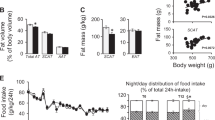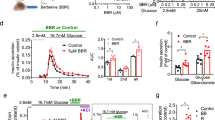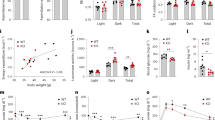Abstract
Abdominal obesity is referred for as a common pathogenic root of multiple risk factors, which include insulin resistance, dyslipidemia, hypertension, and a pro-atherogenic and pro-inflammatory state. Irrespective of its psychiatric side effects, rimonabant through blocking cannabinoid-1 receptor (CB1R) induces an increase in whole body insulin sensitivity. The aim of this work was to study the effect of selected doses of another insulin sensitizer compound BGP-15, and rimonabant on insulin resistance in Zucker obese rats with a promise of inducing insulin sensitization together at lower doses than would have been expected by rimonabant alone. We found that BGP-15 potentiates the insulin sensitizing effect of rimonabant. The combination at doses, which do not induce insulin sensitization by themselves, improved insulin signaling. Furthermore our results suggest that capsaicin-induced signal may play a role in insulin sensitizing effect of both molecules. Our data might indicate that a lower dose of rimonabant in the treatment of insulin resistance and type 2 diabetes is sufficient to administer, thus a lower incidence of the unfavorable psychiatric side effects of rimonabant are to be expected.


Similar content being viewed by others
References
Obesity and overweight WHO fact sheet N°311 (2012)
Howlett AC, Breivogel CS, Childers SR, Deadwyler SA, Hampson RE, Porrino LJ (2004) Cannabinoid physiology and pharmacology: 30 years of progress. Neuropharmacology 47(Suppl 1):345–358
Scheen AJ, Finer N, Hollander P, Jensen MD, Van Gaal LF, RIO-Diabetes Study Group (2006) Efficacy and tolerability of rimonabant in overweight or obese patients with type 2 diabetes: a randomised controlled study. Lancet 368:1660–1672
Literáti-Nagy B, Kulcsár E, Literáti-Nagy Z, Buday B, Pétrfai E, Horváth T, Tory K, Kolonics A, Fleming A, Mandl J, Korányi L (2009) Improvement of insulin sensitivity by a novel drug, BGP-15, in insulin-resistant patients: a proof of concept randomized double-blind clinical trial. Horm Metab Res 41:374–380
Tim C, Noemi T, Stefano P, Peter L-N, Kalman T, Pierre H, Bernadett K, Linda G, Zsolt T, Gabor B, Imre G, Federica C, Simona C, Ferenc G, Gabor N, Zoltan B, Burcin G, Maria P, Attila G, Akos H, Zsuzsanna L-N, Vigh L Jr, Femke H-B, André H, Irma K, Lizette L, Jean-Paul S, Deli Z, Meijering RAM, Henning RH, Brundel BJJM, Kampinga HH, Laszlo K, Zoltan S, Jozsef M, Balazs S, Febbraio MA, Ibolya H, Hooper PL, Laszlo V (2013) Hydroximic acid derivatives: pleiotrophic HSP coinducers restoring homeostasis and robustness. Curr Pharm Des 19(00)
Literati-Nagy Z, Tory K, Literáti-Nagy B, Kolonics A, Vígh L Jr, Vígh L, Mandl J, Szilvássy Z (2012) A novel insulin sensitizer drug candidate-BGP-15-can prevent metabolic side effects of atypical antipsychotics. Pathol Oncol Res 18(4):1071–1076
Gombos I, Crul T, Piotto S, Güngör B, Török Z, Balogh G, Péter M, Slotte PJ, Pilbat AN, Hunya A, Tóth N, Literati-Nagy Z, Vigh L Jr, Glatz A, Brameshuber M, Schütz GJ, Hevener A, Febbraio MA, Horváth I, Vígh L (2011) Membrane-lipid therapy in operation: the HSP co-inducer BGP-15 activates stress signal transduction pathways by remodeling plasma membrane rafts. PLoS One 6(12):e28818
Chung J, Nguyen AK, Henstridge DC, Holmes AG, Chan MH, Mesa JL, Lancaster GI, Southgate RJ, Bruce CR, Duffy SJ, Horvath I, Mestril R, Watt MJ, Hooper PL, Kingwell BA, Vigh L, Hevener A, Febbraio MA (2008) HSP72 protects against obesity-induced insulin resistance. Proc Natl Acad Sci USA 105:1739–1744
Literáti-Nagy Z, Tory K, Literáti-Nagy B, Kolonics A, Török Z, Gombos I, Balogh G, Vígh L Jr, Horváth I, Mandl J, Sümegi B, Hooper PL, Vígh L (2012) The HSP co-inducer BGP-15 can prevent the metabolic side effects of the atypical antipsychotics. Cell Stress Chaperones 17(4):517–521
Guillot E, Coste A, Angel I (1996) Involvement of capsaicin-sensitive nerves in the regulation of glucose tolerance in diabetic rats. Life Sci 59(12):969–977
Porszasz R, Legvari G, Pataki T, Szilvassy J, Nemeth J, Kovacs P, Paragh G, Szolcsanyi J, Szilvassy Z (2002) Sensory nitrergic nature of the hepatic insulin sensitizing substance mechanism in conscious rabbits. Eur J Pharmacol 443(1–3):211–212
Wallenstein S, Zucker CL, Fleiss JL (1980) Some statistical methods useful in circulation research. Circ Res 47(1):1–9
Schäfer A, Pfrang J, Neumüller J, Fiedler S, Ertl G, Bauersachs J (2008) The cannabinoid receptor-1 antagonist rimonabant inhibits platelet activation and reduces pro-inflammatory chemokines and leukocytes in Zucker rats. Br J Pharmacol 154(5):1047–1054
Szilvássy J, Sziklai I, Sári R, Németh J, Peitl B, Porszasz R, Lonovics J, Szilvássy Z (2006) Neurogenic insulin resistance in guinea-pigs with cisplatin-induced neuropathy. Eur J Pharmacol 531(1–3):217–225
Hooper PL, Hooper JJ (2005) Loss of defense against stress: diabetes and heat shock proteins. Diabetes Technol Ther 7:204–208
Hooper PL, Hooper PL (2009) Inflammation, heat shock proteins, and type 2 diabetes. Cell Stress Chaperones 14:113–115
Weiss Y, Bromberg, P. Goloubinoff (2009) Activation of the heat shock response by membrane dependent calcium channel receptors effect in inflammation and cancer Electronic poster Vienna
Kang JH, Kim CS, Han IS, Kawada T, Yu R (2007) Capsaicin, a spicy component of hot peppers, modulates adipokine gene expression and protein release from obese-mouse adipose tissues and isolated adipocytes, and suppresses the inflammatory responses of adipose tissue macrophages. FEBS Lett 581(23):4389–4396
Kunos G, Tam J (2011) The case for peripheral CB1 receptor blockade in the treatment of visceral obesity and its cardiometabolic complications. Br J Pharmacol 163(7):1423–1431
Author information
Authors and Affiliations
Corresponding author
Rights and permissions
About this article
Cite this article
Literati-Nagy, Z., Tory, K., Literáti-Nagy, B. et al. Synergetic Insulin Sensitizing Effect of Rimonabant and BGP-15 in Zucker-Obes Rats. Pathol. Oncol. Res. 19, 571–575 (2013). https://doi.org/10.1007/s12253-013-9620-6
Received:
Accepted:
Published:
Issue Date:
DOI: https://doi.org/10.1007/s12253-013-9620-6




